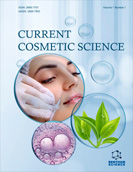Abstract
Aims: The aim of this study was to evaluate the brightening effects of a complex composed of Resorcinol, Arbutin, and Licorice root extract (RAL complex) in patients faced with skin spots compared to a potential hydroquinone compound.
Background: Skin spots are defined as excessive accumulation of melanin pigment in different layers of the skin caused by extravagant sun exposure, pregnancy, and other hormonal and genetic factors. Therefore, it is necessary to use appropriate products to treat these types of spots.
Objective: To evaluate skin brightness after using the RAL complex, this study was designed in a double-blind randomized trial and the removal of melanin pigment and skin spots was evaluated by different methods.
Methods: In this study, the brightening cream formulated with actives comprising the RAL complex in 2.1% w/w concentration and a hydroquinone cream was applied in two groups of 20 women with a mean age of 48 years showing the severity scale 3 of skin pigmentation, separately. This study was conducted to evaluate the brightening effect of this complex compared to a hydroquinone compound after 4, 8, and, 12 weeks of application to the entire face.
Results: The results showed the highest percentage of skin brightness 12 weeks after applying the cream, reported at 93% and 89% for RAL complex and hydroquinone compound, respectively. Skin pigmentation rate was measured before and after applying the RAL complex cream with a mexameter device. The highest amount of dark spot removal was seen after using this cream in different areas of the skin.
Conclusion: The results showed that the RAL complex was more effective than the hydroquinone compound in removing skin blemishes without any side effects compared to products containing hydroquinone.
[http://dx.doi.org/10.3390/cosmetics3040036]
[http://dx.doi.org/10.3390/ijms10094066] [PMID: 19865532]
[http://dx.doi.org/10.1111/jocd.14746] [PMID: 35020267]
[http://dx.doi.org/10.1111/j.1473-2165.2005.40202.x] [PMID: 17166200]
[http://dx.doi.org/10.1016/j.dsi.2014.07.003]
[http://dx.doi.org/10.1111/j.1473-2165.2011.00573.x] [PMID: 21896130]
[PMID: 24847406]
[http://dx.doi.org/10.1159/000509160] [PMID: 32781447]
[http://dx.doi.org/10.1111/srt.12199] [PMID: 25645051]
[http://dx.doi.org/10.1111/j.1524-4725.2011.02065.x] [PMID: 21682796]
[http://dx.doi.org/10.1111/jdv.12051] [PMID: 23205541]
[http://dx.doi.org/10.1201/b16716]
[http://dx.doi.org/10.1016/j.ejps.2019.104992] [PMID: 31302211]
[http://dx.doi.org/10.1111/jdv.12048] [PMID: 23205538]
[http://dx.doi.org/10.1007/s12272-009-1309-8] [PMID: 19387580]
[http://dx.doi.org/10.3390/antiox10071129] [PMID: 34356362]
[http://dx.doi.org/10.3390/cosmetics3030027]
[http://dx.doi.org/10.1046/j.1365-4362.2003.01621.x] [PMID: 12709008]
[http://dx.doi.org/10.3390/antiox8100445] [PMID: 31581512]
[http://dx.doi.org/10.1046/j.1365-4362.1998.00499.x] [PMID: 9646135]
[http://dx.doi.org/10.2147/CCID.S233185] [PMID: 32308462]
[http://dx.doi.org/10.1016/j.yrtph.2014.12.018] [PMID: 25555996]
[http://dx.doi.org/10.1111/j.1346-8138.2008.00522.x] [PMID: 18837701]















